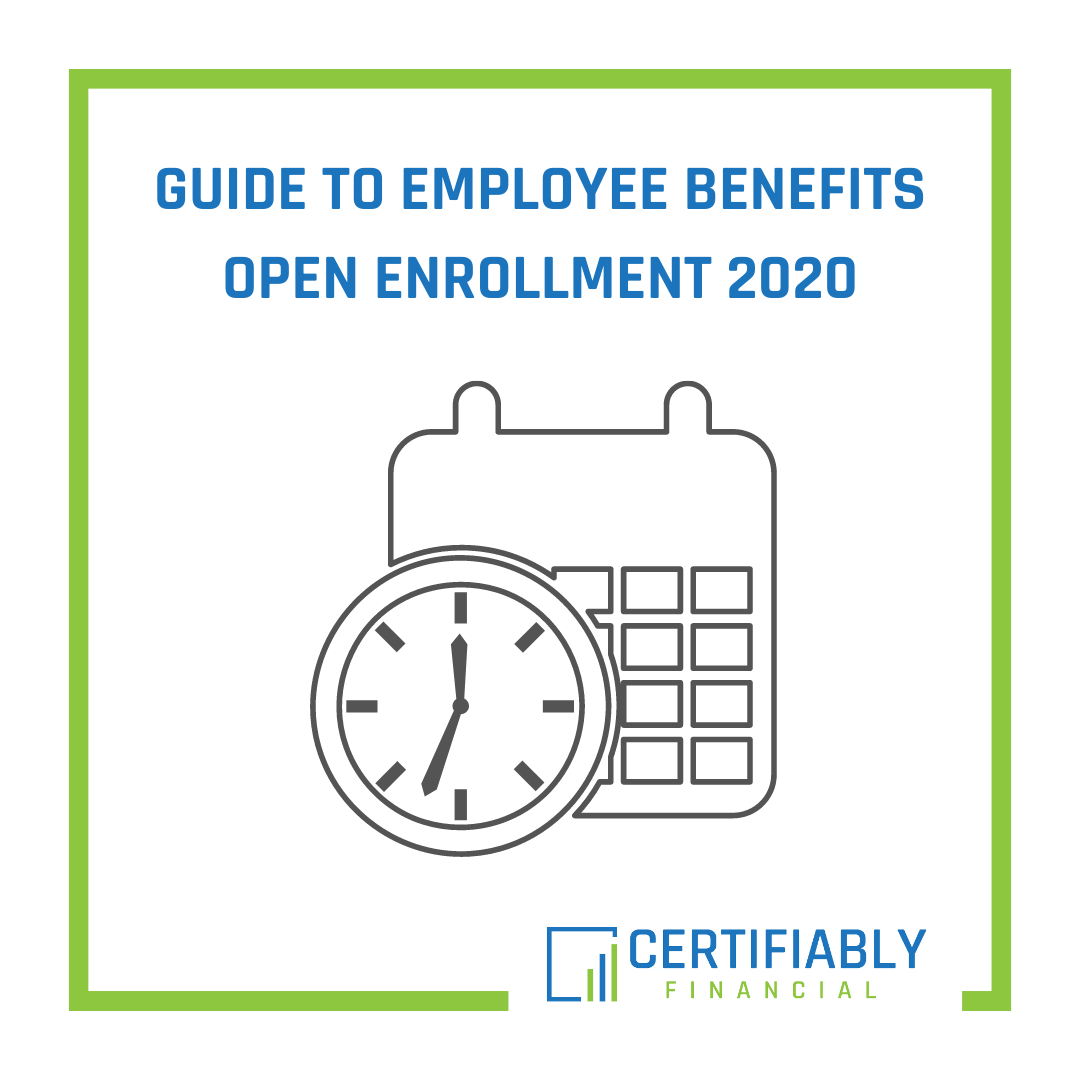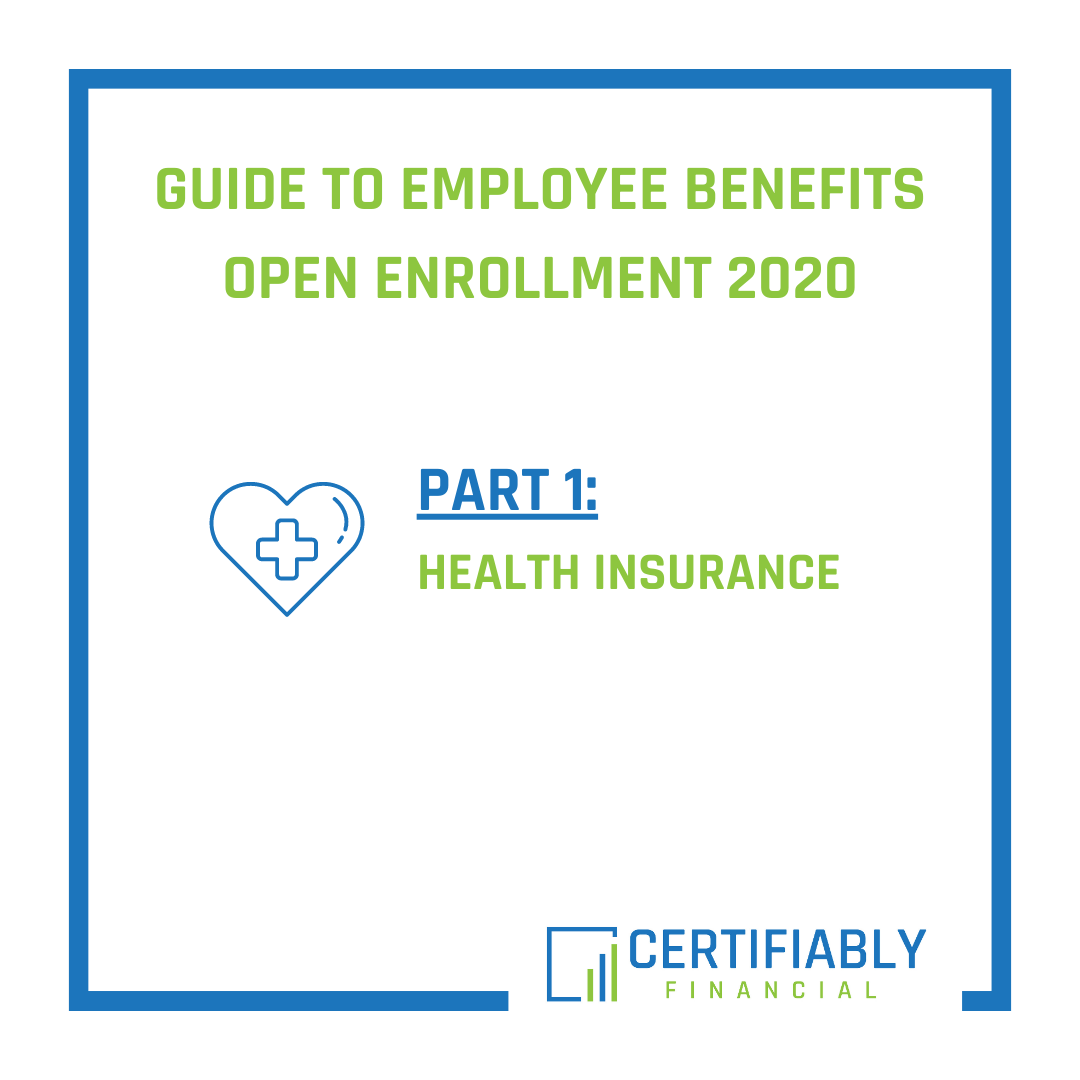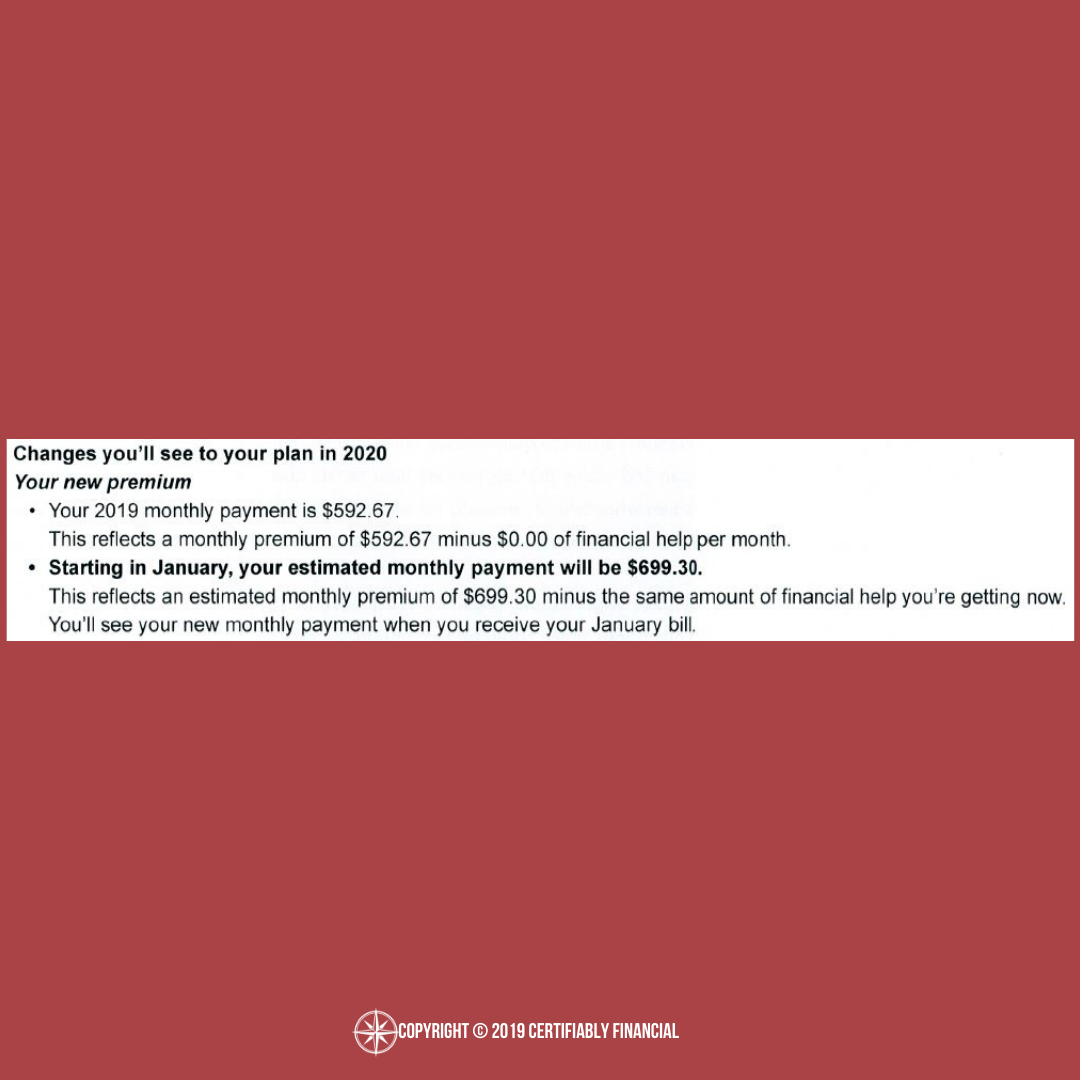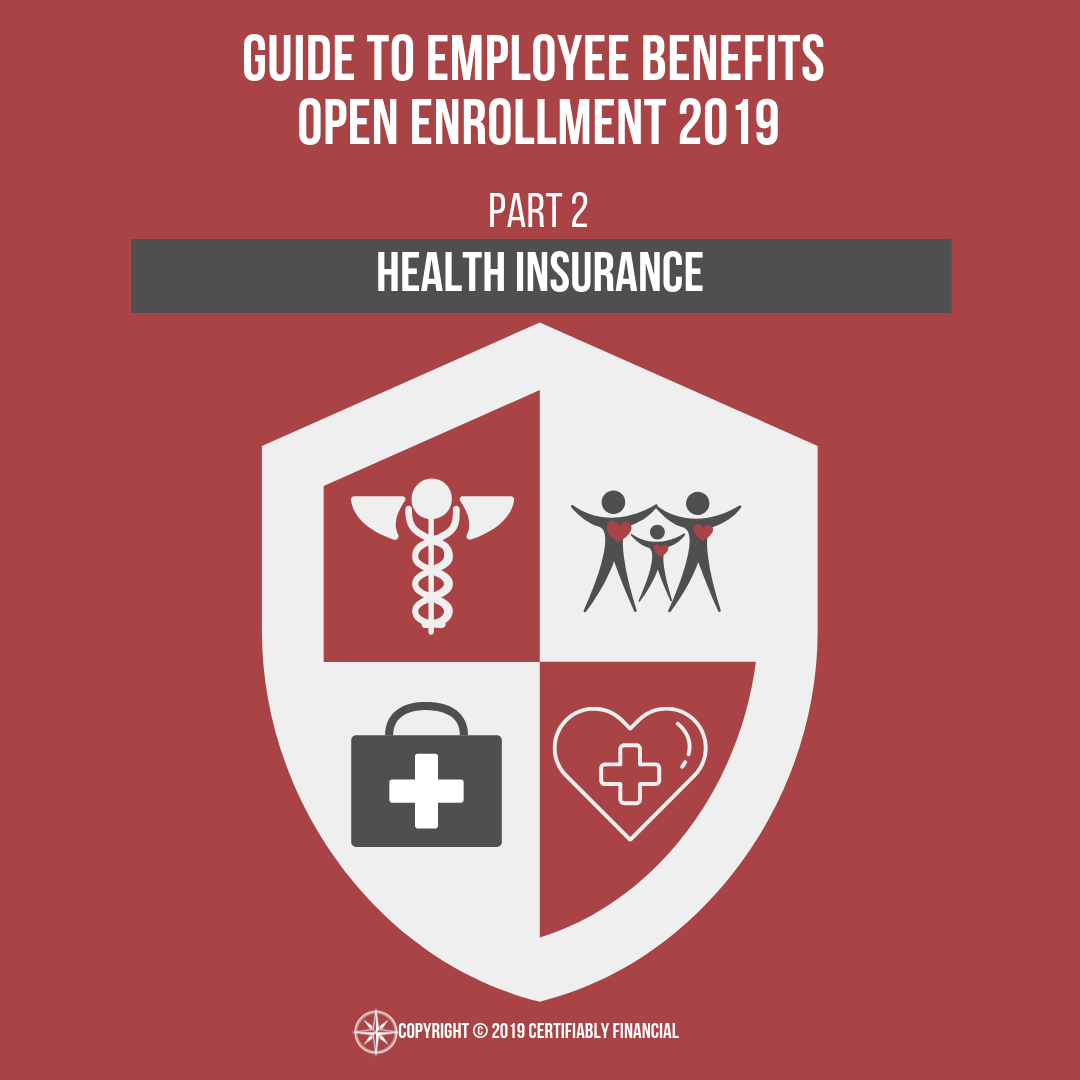Employee benefits open enrollment can be confusing for a lot of people. There are a lot of options to choose from that probably seem like they’re in a different language. My past 5 blog posts have dived into various employee benefits including health insurance, disability insurance, group term life insurance, Dependent Care FSA, and other ancillary benefits to help empower you to make a more educated decision when making your selections for the next year. Personal finance is just that – personal.
Health Insurance
Guide to Employee Benefits Open Enrollment 2020: Health Insurance
Choosing which employee benefits will be best for your family for the next year can be intimidating and there’s often little to no education to help you make those choices. On one hand, you could end up wasting money that would be better used elsewhere on benefits that are highly unlikely to be used and that may not provide much value even if they were.
Day 22 Of 30 Days Of Stay-At-Home Personal Finance Wins: Review Your Insurance Policies
What if you were able to come out of this time of social distancing and economic crisis with a stronger and healthier financial life? What if you looked at this as an opportunity to take a little bit of your extra time each day to work on your finances?
Health Insurance 2019
As someone who hasn’t used a dollar of health insurance so far in 2019, I’m supposed to pay 18% more for health insurance coverage in 2020.
Guide to Employee Benefits Open Enrollment 2019 Part 2: Health Insurance
When making employee benefits elections during open enrollment, choosing which health insurance option you’re going to go with over the next year seems to be something that almost everyone guesses at. Some people opt to choose the plan with the lowest deductible, some choose the option with the lowest premiums, and some choose whatever is in the middle. The problem with choosing your health insurance plan this way is that no real thought around how your and/or your family’s health situation is taken into consideration. With just a little education, I’m sure we can all figure out which plan might be most appropriate for our own personal situations.
Health Insurance Marketplace Open Enrollment 2018
4 minute read
Navigating the health insurance marketplace is very confusing, as I wrote about in September when I turned 26 and had to find a marketplace policy for myself. There are many things to consider such as costs, the type of plan offered, and if your preferred physicians are in the plan’s network.
Different Kinds of Plans
There are several different types of health insurance plans that provide different benefits of which you should be aware. These include Health Maintenance Organizations (HMOs), Preferred Provider Organizations (PPOs), Exclusive Provider Organizations (EPOs), Point-of-Service Plans (POS), and High-Deductible Health Plans (HDHPs).
All of these names seem pretty complicated and don’t really appear to mean much on the surface without diving into them. Out of the 22 plans available through HealthCare.gov in Indiana, the only two types available are HMOs and EPOs, so we’ll focus mainly on these two types of plans. Of those plans, two are HSA-eligible – one is an EPO and one is an HMO.
Here are some important things to know about each type of plan available in Indiana:
Health Maintenance Organizations (HMOs)
- Typically, you must choose a primary care physician and first consult with them before being able to see a specialist.
- Without a referral to a specialist from your primary care physician, you’ll have to pay all costs out-of-pocket.
- HMOs limit you to receiving care from physicians that are contracted with them – this is commonly referred to as the “network”.
- If you receive care (other than emergency care) from an out-of-network physician, then you’ll have to pay out of pocket for those services.
- HMOs can provide cheaper premiums than some other types of health insurance (such as PPOs) since they direct patients towards in-network physicians for an agreed upon amount.
Exclusive Provider Organization (EPO)
- Similar to HMO but may provide a different network.
- May not require that you have a primary care physician.
- Doesn’t require referrals from your primary care physician to see a specialist.
- EPOs limit you to receiving care from physicians that are within the plan’s network (except for emergency services). Otherwise, they won’t pay for the care.
- May provide a larger service area than an HMO.
HSA-Eligible High Deductible Health Plans
- A HDHP is a health insurance plan with a high deductible. Duh. The deductible is the amount that you have to pay before insurance kicks in.
- In 2019, the minimum deductible that a plan can have for self-only coverage to be considered an HDHP is $1,350 and double that at $2,700 for family plans.
- The maximum out-of-pocket expenses for HDHPs in 2019 is $6,750 for individuals and $13,500 for families.
- There are two HDHPs on the marketplace in Indiana – one is an HMO and one is an EPO.
- These plans are the only plans on the market in Indiana that are eligible to be paired with a Health Savings Account (HSA). Even those other plans that have deductibles high enough to be considered “high deductible” plans are not HSA-eligible.
- The 2019 HSA contribution limit for individuals is $3,500 for self-only coverage and $7,000 for those with family coverage.
Choosing between the HMO and EPO really comes down to which network works for you and if you want to be able to see a specialist without a referral from your primary care physician. You can visit each insurance company’s website to review their networks and see if your physicians are in them.
Don’t Go Without It
Don’t wait until December 15 to apply for health insurance coverage for 2019. Login (or create) an account and get a lay of the land. Take some time to figure out what plan is the best for your situation before applying to make sure that you’re making the best decision for you.
Some may think that they’ll just forgo the cost of health insurance since they could save so much and use that money for other things. That’s not a very good idea.
Life is unpredictable, and tragedy could strike at any moment. It’s not what we want to think about, but we must consider that something like a serious car accident is a potential for those of us who drive or take a ride sharing service to work every day. Even something as small as slipping and falling, or anything else that could lead to an emergency room visit, could result in extremely costly medical bills that could be devastating without insurance.
Just as the old saying goes, insurance isn’t something that we like paying for but it’s something that we’re glad is in place once the time comes that we must use it. Yes, health insurance is expensive, but paying for an accident without health insurance is much more expensive.
Health Insurance Options 2018
7 minute read
Special Enrollment Period
If you’re losing coverage under someone else’s plan, such as your parents’, then you have a Special Enrollment Period (SEP) which starts 60 days before you lose coverage and ends 60 days afterwards. The marketplace requires you to choose a plan and pay the premium by the last day of the month that you’re losing coverage to ensure that your new plan coverage is in place on the 1st of the next month.
There could be a gap in coverage if you wait to enroll in a new insurance plan until after the last day of the month that you will lose coverage. For example, since my birthday is September 7th, I have to choose a plan by September 30th to ensure that I will have coverage in place October 1. Your new plan will either start the first day of the month after you lose coverage if you enroll before you lose coverage, or will start the first day of the month after you pick a plan if you enroll after you lost coverage.
You don’t want to get in a car accident, break a bone, or get hurt exercising and not have health insurance to help pay for your bills. A serious injury or illness could be catastrophic to your financial situation.
Health Insurance Options When You Don’t Have Employer-Provided Coverage
You can read a bunch of articles telling you about all of your options, but they’re limited. Essentially, at this time, you’re limited to the options I’ve listed below. Before we start, here are some considerations to keep in mind when evaluating potential health insurance options:
- Are your doctors in the plan network?
- Are your prescription drugs covered?
- What are the premiums?
- What is the deductible?
- What is the coinsurance rate?
- What is the max out-of-pocket cost?
Health Insurance Marketplaces
This is likely where most people who are losing health insurance coverage will land. While some states have their own marketplaces, most, including Indiana, use HealthCare.gov. You can find out if your state has its own marketplace or uses the federal marketplace by going to HealthCare.gov and entering your zip code.
Currently, CareSource & Ambetter are the only options on the marketplace for people who don’t have group benefits available to them in Indiana. The HealthCare.gov marketplace serves less than 10% of insured people, which is why health insurers have continued to drop out. They can make so much more money offering group policies than offering individual policies with expensive government mandates.
Since insurers continue to pull out of the marketplace, most of these plans will probably not provide these same level of benefits as the coverage that you’re losing (or COBRA) and will likely be more expensive than what you were used to. Nevertheless, this is the health insurance landscape in which we live.
HSA-Eligible High Deductible Health Plans
As I’ve written before, High Deductible Health Plans that are eligible for use with a Health Savings Account (HSA) can be extremely beneficial for some people. I’m one of those people.
Don’t be fooled – most plans on the marketplace that you’d think would be HSA-eligible at first glance actually are NOT. In fact, there are only 2 plans that qualify as HSA-eligible in my area. Even though there are many more of these plans that have high deductibles, which you’d think would make them qualify as HDHPs, they don’t qualify because they provide additional benefits above and beyond those that HSA-eligible plans are allowed to offer.
That’s right. They provide too many benefits to be HSA-eligible.
Healthcare Sharing Programs
Healthcare sharing programs are not health insurance, but they usually act a lot like it.
Along with the traditional health insurance marketplaces, I believe that most people will find replacement coverage through one of these first two avenues. Healthcare Sharing Programs are faith-based programs which share medical expenses among members. Most Healthcare Sharing Programs will require you to sign a statement of faith and agree to live by their guidelines. They function very similarly to insurance but, technically, aren’t insurance. However, they do meet the IRS guidelines to ensure that you won’t be penalized for not having insurance.
The benefit of Healthcare Sharing Programs is that the premiums typically are much less expensive than traditional health insurance since they expect their members to take care of themselves and to pay most costs out of pocket, including preventative services. Coverage under these plans is usually more limited than health insurance and healthcare costs related to “unbiblical” acts are not covered.
Although these programs don’t provide coverage for many services such as preventative care, many healthy people will still end up ahead when compared to exchange plans due to the very low premiums. However, this can be a case-by-case and program-by-program basis, so you need to do your research and make sure that you know the particulars of the one that you’re considering.
One downside to these plans is that they currently do not qualify to be paired with an HSA, even though many of the deductibles are well above the HSA-eligible HDHP limits. Additionally, many of them don’t provide prescription drug coverage. To help with that, you can use a website such as goodrx.com to find coupons for prescription drugs.
There are a ton more details about these programs (there are many options based on different faiths and belief systems) that you can read about here.
Catastrophic Health Insurance
As the name suggests, these policies don’t provide a great deal of coverage. Catastrophic health insurance plans are limited in that only those who are under 30 years old, or those with a hardship exemption or affordability exemption, are eligible to purchase them. Additionally, these plans have low monthly premiums and very high deductibles – $7,150 in 2017. Just as the name implies, they’re really only in place to cover catastrophic events.
Short-Term Health Insurance
Short-term health insurance is a cheaper alternative to traditional plans that offers much less comprehensive coverage than exchange plans. Just remember with these plans – you pay for what you get. Yes, the premiums are extremely cheap, but that’s because these are very similar to catastrophic health plans that offer less benefits and protection than traditional insurance. If you decide to pursue one of these plans, then make sure that you read the fine print carefully.
Catastrophic health plans can last up to one year (many are 3-month plans) and can be renewed for up to 36 months beginning October 2018.
Benefits of these plans are that you can apply at any time and get coverage very quickly. They can be used to make sure that you don’t have a lapse in coverage if you’re changing jobs or will be without health insurance for a short period of time. Some potential downsides to short-term health insurance plans are that they don’t have to offer coverage to everyone like exchange plans do. Those who apply must go through medical underwriting which means that a preexisting condition or bad medical history could keep you from getting coverage.
Most short-term health insurance plans don’t provide prescription drug coverage and many also exclude other coverages such as maternity, hospital coverage, and mental health care. Some don’t even cover preventative care. Also, the deductibles can be extremely high on these plans – I saw some with deductibles of up to $10,000!
These plans do not meet ACA coverage mandates to avoid the tax penalty. They’re called short-term for a reason. This type of insurance is designed to cover gaps between jobs or short lapses in health insurance coverage.
Student Health Plan
Many universities offer basic health insurance to students, which counts as qualifying coverage. This doesn’t apply to me, and is dependent as to what each university offers, so I didn’t explore this in-depth.
Medicaid
Medicaid is government-provided health insurance (free or low-cost) for those considered low-income and those who are disabled. You can find out if you qualify for Medicaid by visiting your state’s Medicaid website.
Trade Organization or Association
I saw this as an option a couple of places, however, health insurance isn’t available to me through any of the organizations and associations that I’m a part of.
Off-Exchange Plans
You’ll read articles telling you that you can find off-exchange health insurance plans. These articles are out-of-date, at least according to the research I’ve done regarding the health insurance landscape in Indiana. There are only a handful of insurers on the Federal exchange (Indiana doesn’t have its own marketplace) and those that used to offer off-exchange plans now only provide group plans due to the costliness of providing off-exchange plans to individuals.
COBRA
COBRA allows you to continue your current employer-provided coverage for 18-36 months (depending on reason for loss). However, the kicker is that you’ll have to pay the full cost of the coverage – the part that the employer was paying as well as part that the you were paying as the employee. In my case, this was to the tune of $765 per month for a HDHP or $930 per month for a PPO plan. No thanks.
Dental & Vision Insurance
When you lose health insurance coverage, you’re going to lose dental and vision coverage as well. The dental insurance plans that I found on the exchange were less than stellar, to say the least. So, I called my dentist’s office and asked about private paying for my dental costs.
I was informed of the Cigna Dental Savings Plan which is a discount program negotiated with dentists. I’ll pay $96 for a year of the Cigna plan and receive discounted prices through my dentist office. Based on the information provided by the person I spoke to on the phone, the $96 more than pays for itself just for the basic dental expenses that I incur on an annual basis. Obviously, you’ll want to use the Dentist Search feature and make sure that your dentist accepts this plan.
I’ve not pursued it yet, but I know that there is private vision insurance as well as discount vision plans available similar to the Cigna Dental Savings Plan.
Conclusion
I’d recommend researching your options if you’re aging off of your current health insurance coverage or your currently don’t have coverage. However, keep in mind that Special Enrollment Periods are limited and, if you’ve missed it, you could have to wait until Open Enrollment to pick up a marketplace plan. Hopefully, I’ve given you a decent overview of what’s available to you and what to look out for as you choose a health insurance plan.
Good luck and let me know if you stumble across anything that I missed!
The Most Useful Employee Benefits That You’re Not Taking Advantage Of
3 minute read
Of course, not all of these benefits are available to everyone and I haven’t included things such as life insurance because almost everyone signs up for it. Below, I’ve listed benefits that I often see people not taking advantage of when they really should be.
High Deductible Health Plan (HDHP) Paired with a Health Savings Account (HSA)
Although HDHPs may seem scary on the surface, they can provide great benefits to those who are healthy, especially when combined with an HSA. Not only can HDHPs save you money through lower premiums if you don’t visit the doctor often, but many HDHPs that are offered as an employee benefit are HSA-eligible.
HSAs are currently the most tax-advantaged accounts out there. They can be used as a means to save for and pay for any qualified medical expenses in a tax-free manner or you can strategize to use them as the only tax-free savings vehicle available to you. Additionally, if an HSA is available to you, then your employer likely offers to contribute to it on your behalf which ultimately lowers the cost of heath care for you even further.
Pre-Tax Dependent Care Benefits Through Dependent Care Flexible Spending Account (FSA)
If you’re paying for dependent care, then this is a no-brainer. You’re already paying for daycare, it’s really expensive, and you’re paying for it with after-tax dollars. If your employer offers a dependent care FSA, then you can contribute up to $5,000 to the account pre-tax for those married and filing jointly, or $2,500 for single taxpayers and those married filing separately, and then reimburse yourself tax-free.
If you are a married filing jointly taxpayer in the 24% tax bracket and you contribute $5,000 to a dependent care FSA, then you could save $1,200 on your taxes. There’s no reason not to take advantage of this if it’s available to you.
Long-Term Disability Insurance
According to the Social Security Administration, 1 in 4 of today’s 20-year-olds will become disabled before they retire. Many people don’t have disability insurance in place simply because they don’t know what it is, or they think they’ll never need it, but it could be disastrous if you end up needing it and you don’t have coverage in place. If you become disabled due to a freak accident, a disease, or mental health condition and can’t work, then how will you earn money, put food on the table, or provide for your family until you reach Social Security age? This is exactly what disability insurance protects against.
Not all disability insurance policies are written the same, and the devil is in the details when it comes to the policies, so it’s worth exploring private policies as well.
Vacation
As a whole, American companies offer fewer vacation days than many other nations. Yet, Americans still leave many of these days on the table. In fact, over half of Americans report having unused vacation days left over at the end of the year. Why? Even if you’re not going on vacation take that time to spend time with your family, enjoy your hobbies, or just relax.
The way I see it is that if your boss values you less for taking all of your vacation days than someone who doesn’t take all of their days, then you need to find a new boss.
Be a little more intentional when making your employee benefits elections. If there’s no one there to help you and answer your questions, then reach out to someone you trust who has knowledge about the benefits being offered to you and can accurately answer your questions.
Are You Afraid of High Deductible Health Plans?
3 minute read
However, HDHPs can often actually be cheaper options over the course of a year and can be great selections for many when combined with a Health Savings Account (HSA). Keep in mind that not all HDHPs are HSA-eligible. Check with your benefits provider to find out if yours is.
High Deductible Health Plan (HDHP)
The minimum annual deductible for self-only HDHP coverage in 2018 is $1,350 while the minimum annual deductible for family HDHP coverage is $2,700. However, most employer-provided health plans will require higher deductibles than these amounts. The 2018 out-of-pocket (OOP) maximum for self-only HDHP coverage in 2018 is $6,650 while the OOP maximum for family HDHP coverage is $13,300. Medical plans can have lower OOPs than this, but they cannot be higher.
Looking at these numbers is the main reason most people shy away from these plans.
But why do you care if you’re healthy and only visit the doctor a couple of times per year for minor things? The premiums of a HDHP will be lower than a PPO or HMO. If you only go to the doctor a couple of times per year, then you’ll only have to pay the premiums and medical bills that you incur, which will be at a lower cost as negotiated by your insurer. However, if you do have a catastrophic health event that results in large medical bills, then the HDHP could be more expensive.
Health Savings Account (HSA)
My colleague, Aaron Williams, wrote a great blog post about the power of HSAs titled, Announcing The King Of All Savings Accounts: The HSA. HSAs are the most tax-advantaged account available today and many HDHPs allow you to open an HSA to help save for medical expenses.
Money that you put into an HSA goes in pre-tax, including pre-FICA taxes (Social Security & Medicare taxes) if you make contributions through payroll, can be invested within the account and grow tax-free, and can be withdrawn tax-free for qualified medical expenses. Money that you put into your retirement account doesn’t even go in pre-FICA and I can’t think of another account that you can essentially use as a tax-free savings vehicle.
Not only do HSAs have tremendous tax benefits, but you could also strategize and pay all of your medical expenses out of pocket, save all of your receipts, invest your HSA account and allow it to grow tax-free, and reimburse yourself at some point in the future for those receipts that you’ve been saving. There currently aren’t any laws that prohibit this. However, this strategy requires deeper explanation for another post.
Another advantage is that many employers contribute to employee HSAs just like they would contribute to your retirement account. You can take that money as a contribution to your savings or you can use it to pay for any medical bills. Regardless, any employer contribution should be factored into the cost comparison of health insurance options.
I recommend reading Aaron’s article for more benefits to using an HSA.
Analyze The Costs
Oftentimes, choosing the high deductible health plan option over the other options offered, including PPOs and HMOs, is cheaper when comparing all costs for those who are relatively healthy and won’t incur many healthcare expenses. However, most people simply don’t take the time to do the analysis. Yes, the deductible on a High Deductible Health plan will be higher than the other plans, but that can be made up for with lower monthly premiums, tax advantages, and, potentially, employer contributions to your HSA.
Open enrollment for many employers is around the corner and while I can’t say that choosing a HDHP with an HSA is the best choice for everyone, it’s probably worth looking into if you don’t typically incur many healthcare expenses.









